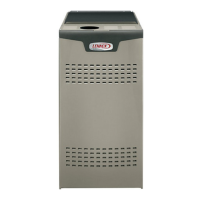Page 17
Ignition Control 103130-XX Diagnostic Codes Continued
Code Diagnostic Codes/Status of Equipment Action Required to Clear and Recover
E271 Soft lockout - Exceeded maximum number of re-
tries. Last retry failed due to the pressure switch
opening.
Check pressure (inches w.c.) of low pressure switch clos-
ing on heat call. Measure operating pressure (inches w.c.).
Inspect vent and combustion air inducer for correct oper-
ation and restriction. Clears when heat call nishes suc-
cessfully.
E272 Soft lockout - Exceeded maximum number of re-
cycles. Last recycle due to the pressure switch
opening.
Check operation of low pressure switch to see if it is stuck
closed on heat call. Check pressure (inches w.c.) of high
pressure switch closing on heat call. Measure operating
pressure (inches w.c.). Inspect vent and combustion air
inducer for correct operation and restriction. Clears when
heat call nishes successfully.
E273 Soft lockout - Exceeded maximum number of re-
cycles. Last recycle due to ame failure.
Check micro-amperes of ame sensor using control diag-
nostics or eld-installed mode. Clean or replace sensor.
Measure voltage of neutral to ground to ensure good unit
ground. Clears when heat call nishes successfully.
E274 Soft lockout - Exceeded maximum number of re-
cycles. Last recycle failed due to the limit circuit
opening or limit remained open longer than 3 min-
utes
Shut down system. 1-hour soft lockout. Check ring rate
and air ow. Check for blockage. Clears when heat call
nishes successfully.
E275 Soft lockout - Flame sensed out of sequence.
Flame signal is gone.
Shut o gas. Check for gas valve leak. 1-hour soft lockout.
Clears when ame has been proven stable.
E276 Watchguard calibration failure. Unable to perform pressure switch calibration. Check vent
system and pressure switch wiring connections. 1-hour soft
lockout. Clears when calibration has nished successfully.
E290 Ignitor circuit fault - Failed ignitor or triggering cir-
cuitry.
Measure resistance of hot surface ignitor. Replace if open
or not within specications. 1-hour soft lockout. Clears
when ame has been proven stable.
E291 Heat air ow restricted below the minimum. Check for dirty lter and air ow restriction. Check blower
performance. 1-hour soft lockout. Cleared when heat call
nishes successfully.
E292 Indoor blower motor unable to start due to ob-
structed wheel, seized
bearings.
Indoor blower motor unable to start (seized bearing, stuck
wheel, etc.). Replace motor or wheel if assembly does not
operate or meet performance standards. 1-hour soft lock-
out. Clears after circulator successfully starts.
E294 Combustion air inducer over current. Check combustion blower bearings, wiring and amps. Re-
place if does not operate or does not meet performance
standards. Clears after inducer current is sensed to be in-
range after the ignition following the soft lockout or reset.
E295 Indoor blower motor temperature is too high. Indoor blower motor over temperature (motor tripped on
internal protector). Check motor bearings and amps. Re-
place if necessary. Cleared after blower demand is satis-
ed.
E310 Discharge error temperature sensor failure. Only
shown if shorted or
out of range.
Compare outdoor sensor resistance to temperature/ re-
sistance charts in installation instructions. Replace sensor
if necessary. Cleared in Communicating mode: 30 sec-
onds after fault recovered. In Non- Communicating mode:
Cleared after the current heat call is completed.
E311 Heat rate reduced to match indoor blower air ow. Warning Only. Furnace blower in cutback mode due to
restricted airow. Reduce ring rate every 60 seconds to
match available CFM. Check lter and duct system. To
clear, replace lter if needed or repair/ add duct. 2-stage
controls will reduce ring rate to 1st stage. Clears when
heat call nishes successfully.

